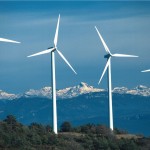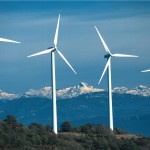 Complicated things sometimes can be explained in only a few words – check out EWEA’s FAQs to find the answers to your wind questions you were always looking for.
Complicated things sometimes can be explained in only a few words – check out EWEA’s FAQs to find the answers to your wind questions you were always looking for.
When talking about wind turbines and their capacity – that is, their ability to generate electricity — the word megawatt is used all the time. Capacity is measured in watts which is a very small unit, so people talk instead about kilowatts (1 kW = 1,000 watts), megawatts (1 MW = 1 million watts), and gigawatt (1 GW = 1 billion watts) when they want to describe the capacity of generating units like wind turbines.
The electricity production and consumption, on the other hand, is measured in kilowatt hours (kWh). A kilowatt hour means one kilowatt (1,000 watts) of electricity produced or consumed for one hour. That means one 50-watt light bulb left on for 20 hours consumes one kilowatt-hour of electricity (50 watts x 20 hours = 1,000 watt-hours = 1 kilowatt hour).
 Wind power in Turkey should benefit from a 72-point plan announced by the government that is designed to increase the nation’s competitiveness in global markets.
Wind power in Turkey should benefit from a 72-point plan announced by the government that is designed to increase the nation’s competitiveness in global markets.
Turkey’s Industry and Commerce Minister Nihat Ergün announced the “Industry Strategy Document and Action Plan”, which includes the establishment of giant ports, logistics bases and railways, at a conference on Wednesday, according to the Anatolia News Agency.
“In an effort to improve energy efficiency, the plan foresees the establishment of methods to utilise the country’s potential in energy resources, including hydroelectricity, wind, geothermal, solar and biomass,” the story added. “The government will encourage the use of products that rely on alternative energy resources.”
 By Justin Wilkes
By Justin Wilkes
All 27 National Renewable Energy Action Plans have now been submitted to the European Commission. We at EWEA have done an analysis of the plans. As expected they show that the EU as a whole will exceed its target of 20% of energy from renewables by 2020.
Taking all 27 National Renewable Energy Action Plans together we see that EU countries expect to meet 20.7% of their energy consumption from renewables.
This would mean that 34% of all electricity in the EU in 2020 would come from renewables – 14% from wind energy alone: making wind Europe’s leading renewable energy source.
 Reviewing a year’s worth of work can focus the mind on important developments. That seems especially true for wind power, which in 2010 was embraced by, among other organisations, Ikea, Google, Bacardi and the US Army.
Reviewing a year’s worth of work can focus the mind on important developments. That seems especially true for wind power, which in 2010 was embraced by, among other organisations, Ikea, Google, Bacardi and the US Army.
With those eclectic endorsements in mind, here are 10 developments from 2010 that have stuck with me:
1. Thumbs down to the US Senate for killing off a modest climate change bill due to partisanship and lobbying by narrow self-interests. Thumbs up, though, to Energy Secretary Steven Chu and Interior Secretary Ken Salazar, who are both big promoters of wind energy.
 Scotland continues promoting its very aggressive pro-wind position as a way of driving increased energy security, a green economy and mitigating climate change.
Scotland continues promoting its very aggressive pro-wind position as a way of driving increased energy security, a green economy and mitigating climate change.
The latest development occurred last week when First Minister Alex Salmond and more than 30 senior energy industry leaders met in Aberdeen to talk about the oil and gas industries and the renewable power sector collaborating to advance Scotland’s transition to a low carbon economy.
“Scotland already, per head of population, has ten-times the renewable energy of England but as the industry moves offshore we have even more potential,” Salmond told the summit Friday.
 Complicated things sometimes can be explained in only a few words – check out EWEA’s FAQs to find the answers to your wind questions you were always looking for.
Complicated things sometimes can be explained in only a few words – check out EWEA’s FAQs to find the answers to your wind questions you were always looking for.






 Comments
Comments



